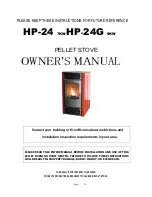
XIII. FLUE DRAUGHTS
Draught is created by warm air exiting the stove and rising in the collar air of the chimney.
Prior to installation, the chimney can be checked with a smoke pellet. If the chimney does not pull the
smoke, it may need attention. Seek advice from a qualified, HETAS
†
registered chimney engineer.
It is very important to maintain an adequate draught at all times. The following factors can affect the
draught.
1. An air leak in the stove or chimney.
2. Faulty stove or door gaskets, or doors not closed tightly.
3. The stove pipe, outlet or chimney is blocked.
4. The chimney temperature.
5. Obstructions such as trees or buildings close to the top of the chimney.
6. The chimney flue is too large.
7. Vented exhaust fans (such as in a kitchen) are causing low draught and pulling air downwards.
CAUTION:
Some of these situations can cause down draught which is dangerous. Seek expert advice.
If you have doubts about any of these issues, do not use the stove and contact a HETAS
†
registered
installer immediately.
XIV. MAINTENANCE
It is essential to regularly maintain your stove and clean you chimney. Failure to do so can cause
poisonous gases to enter your home. The stove should only be cleaned when it is cold.
DAILY CARE:
A daily wipe-over with a lint-free cloth, hot water and soap is sufficient to clean the stove
on a daily basis. The door glass can be cleaned with glass cleaning liquids purchased from stove shops,
and a dry cloth.
REGULAR CARE:
The stove should be inspected for fly ash build up bi-monthly during the heating season.
Pay attention to the elbows in the stove pipe as this is where ash tends to accumulate.
CHIMNEY CLEANING:
It is important that your installer provides access to the chimney and connecting
flue pipe for cleaning. The design of some models does not allow sweeping through the stove. Cleaning
doors must always be accessible.
†
or equivalent local body


































